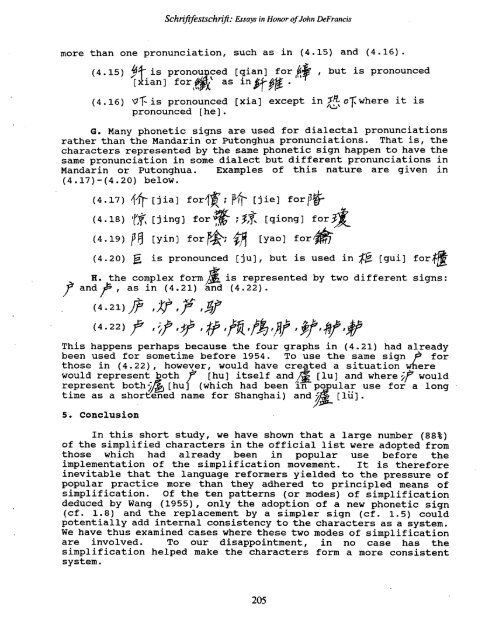Essays on Writing and Language in Honor - Sino-Platonic Papers
Essays on Writing and Language in Honor - Sino-Platonic Papers
Essays on Writing and Language in Honor - Sino-Platonic Papers
You also want an ePaper? Increase the reach of your titles
YUMPU automatically turns print PDFs into web optimized ePapers that Google loves.
Schn'$t$iestschrifr: &says <strong>in</strong> Homr of John DeFrancis<br />
more than <strong>on</strong>e pr<strong>on</strong>unciati<strong>on</strong>, such as <strong>in</strong> (4.15) <strong>and</strong> (4.16).<br />
, but is pr<strong>on</strong>ounced<br />
(4.16) UF is pr<strong>on</strong>ounced [xia] except <strong>in</strong> LR 0% where it is<br />
pr<strong>on</strong>ounced [he].<br />
G. Many ph<strong>on</strong>etic signs are used for dialectal pr<strong>on</strong>unciati<strong>on</strong>s<br />
rather than the M<strong>and</strong>ar<strong>in</strong> or Put<strong>on</strong>ghua pr<strong>on</strong>unciati<strong>on</strong>s. That is, the<br />
characters represented by the same ph<strong>on</strong>etic sign happen to have the<br />
same pr<strong>on</strong>unciati<strong>on</strong> <strong>in</strong> some dialect but different pr<strong>on</strong>unciati<strong>on</strong>s <strong>in</strong><br />
M<strong>and</strong>ar<strong>in</strong> or Put<strong>on</strong>ghua. Examples of this nature are given <strong>in</strong><br />
(4.17) - (4.20) below.<br />
(4.17) (+[jia] for{$;: \ [jie] for?&<br />
(4.18) [j<strong>in</strong>g] for% : 3% [qi<strong>on</strong>g] for<br />
(4.19) 84 [y<strong>in</strong>] for&; [yao] for&<br />
(4.20) is pr<strong>on</strong>ounced [ju], but is used <strong>in</strong> $E [gui] for*<br />
H a the complex form,& is represented by two different signs:<br />
,? <strong>and</strong>p , as <strong>in</strong> (4.21) <strong>and</strong> (4.22).<br />
This happens perhaps because the four graphs <strong>in</strong> (4.21) had already<br />
been used for sometime before 1954. To use the same sign for<br />
those <strong>in</strong> (4.22) , howeyer, would dre<br />
would represent both P [hu] itself where ;$ would<br />
represent bothfa [hu (which had use for a l<strong>on</strong>g .<br />
time as a shor ened name for Shanghai)<br />
5. C<strong>on</strong>clusi<strong>on</strong><br />
In this short study, we have shown that a large number (88%)<br />
of the simplified characters <strong>in</strong> the official list were adopted from<br />
those which had already been <strong>in</strong> popular use before the<br />
implementati<strong>on</strong> of the simplificati<strong>on</strong> movement. It is therefore<br />
<strong>in</strong>evitable that the language reformers yielded to the pressure of<br />
popular practice more than they adhered to pr<strong>in</strong>cipled means of<br />
simplificati<strong>on</strong>. Of the ten patterns (or modes) of simplificati<strong>on</strong><br />
deduced by Wang (1955) , <strong>on</strong>ly the adopti<strong>on</strong> of a new ph<strong>on</strong>etic sign<br />
(cf. 1.8) <strong>and</strong> the replacement by a simpler sign (cf. 1.5) could<br />
potentially add <strong>in</strong>ternal c<strong>on</strong>sistency to the characters as a system.<br />
We have thus exam<strong>in</strong>ed cases where these two modes of simplificati<strong>on</strong><br />
are <strong>in</strong>volved. To our disappo<strong>in</strong>tment, <strong>in</strong> no case has the<br />
simplificati<strong>on</strong> helped make the characters form a more c<strong>on</strong>sistent<br />
system.

















